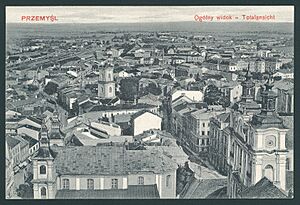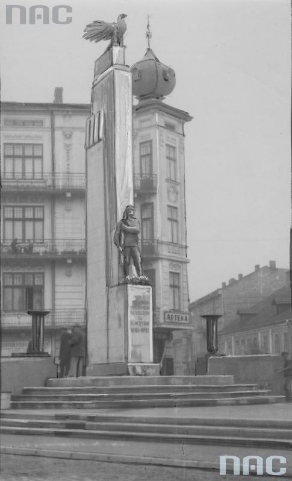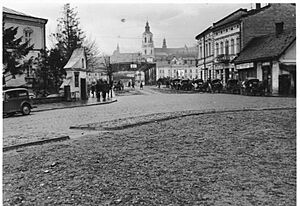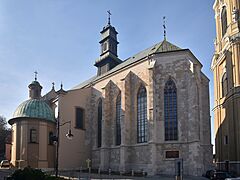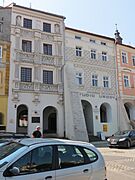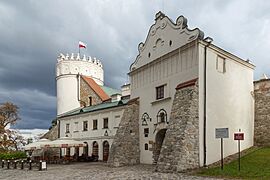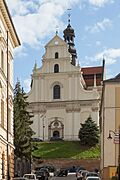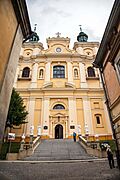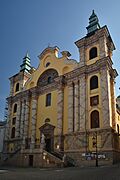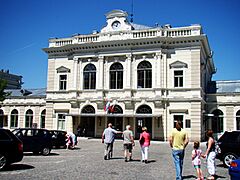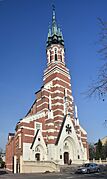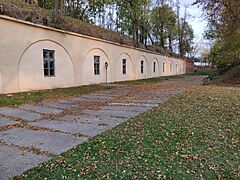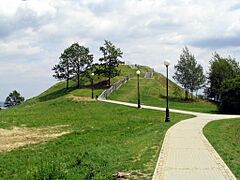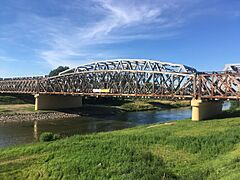Przemyśl facts for kids
Quick facts for kids
Przemyśl
|
|||
|---|---|---|---|
|
City-County
|
|||
|
From top, left to right: Przemyśl Cathedral with the city in the background, Market Square, Royal Castle
|
|||
|
|||
| Country | |||
| Voivodeship | |||
| County | city county | ||
| Established | c. 8th century | ||
| City rights | 1389 | ||
| Area | |||
| • Total | 44 km2 (17 sq mi) | ||
| Population
(30.06.2023)
|
|||
| • Total | 56,466 |
||
| Time zone | UTC+1 (CET) | ||
| • Summer (DST) | UTC+2 (CEST) | ||
| Postal code |
37–700 to 37–720
|
||
| Area code(s) | +48 16 | ||
| Car plates | RP | ||
|
Invalid designation
|
|||
| Official name: Przemyśl – Old Town ensemble | |||
| Designated: | 2018-12-10 | ||
| Reference #: | Dz. U., 2018, No. 2419 | ||
Przemyśl is a city in southeastern Poland with about 56,000 people living there as of 2023. It's located in the Subcarpathian Voivodeship.
Przemyśl has a long and interesting history because of its great location. It sits where mountains meet lowlands, in an area called the Przemyśl Gate. This spot has good transport routes and rich soil. The city is also on the San River, which is easy to travel on by boat. Important trade routes pass through Przemyśl, making it a key city. The old part of Przemyśl is even listed as a Historic Monument of Poland.
Since the Russian invasion of Ukraine started in February 2022, Przemyśl has become a safe place for many Ukrainians. This is because it's close to the Poland–Ukraine border and is the end point of the railway line from Lviv, Ukraine.
Contents
City Names Through History
Over time, Przemyśl has been known by different names in various languages. Some of these names include:
- Czech: Přemyšl
- German: Premissel, Prömsel, Premslen
- Latin: Premislia
- Ukrainian: Перемишль (Peremyshl) and Пшемисль (Pshemysl)
- Yiddish: פּשעמישל (Pshemishl)
A Look Back at Przemyśl's History
Early Beginnings
Przemyśl is the second-oldest city in southeastern Poland, after Kraków. Its story goes all the way back to the 8th century. It started as a strong, fortified settlement belonging to the Ledzianie, a West Slavic tribe. In the 9th century, this area became part of Great Moravia. The city's name likely comes from this time. We also know that a Christian settlement was here as early as the 9th century.
Around 899, Hungarian tribes invaded Great Moravia. The local Lendians then joined forces with the Hungarians. After this, the region became a battleground between Poland, Kievan Rus, and Hungary. Przemyśl, along with other towns, came under the control of the Polans. These Polans later formed the Polish state under Mieszko I in the 10th century. When Mieszko I took over the Lendians' land around 970–980, Przemyśl became an important place on Poland's eastern border.
In 981, the city was mentioned by a historian named Nestor the Chronicler, who wrote that it was captured by Vladimir I of Kiev. Przemyśl returned to Poland in 1018, but the Rus' took it back in 1031. Around 1069, it was again part of Poland when Bolesław II the Generous recaptured it. In 1085, the town became the capital of a semi-independent area called the Principality of Peremyshl, under the rule of Kievan Rus'.
A large palace complex, including a Latin church, was built in the 11th century by Polish king Bolesław I the Brave. Later, an Eastern Orthodox church was founded in the city before 1218. Przemyśl then became part of the Kingdom of Galicia–Volhynia. From 1246, it was under the rule of the Mongols.
Polish Kingdom and Commonwealth Era
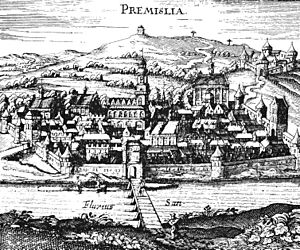
In 1340, King Casimir III of Poland took Przemyśl back, and it became part of the Kingdom of Poland again. Around this time, the first Latin Catholic church area was set up in the city. Przemyśl was also given special city rights based on Magdeburg rights, which were confirmed in 1389 by King Władysław II Jagiełło.
The city thrived as an important trade center in the 16th century. Like nearby Lwów, it had many different groups of people living there. These included Poles, Jews, Germans, Czechs, Armenians, and Ruthenians. This long period of success allowed for the building of public places like the Renaissance town hall and the Old Synagogue in 1559. A Jesuit school was also started in the city in 1617.
This good time ended in the mid-17th century because of the invading Swedish army during a period known as the Deluge. This also led to a general decline of the Polish–Lithuanian Commonwealth. The city's decline lasted for over a hundred years. It only started to recover its population levels at the end of the 18th century. In 1754, the Latin Catholic bishop started Przemyśl's first public library. This was only the second public library in the Polish–Lithuanian Commonwealth.
Under Austrian Rule
In 1772, Przemyśl became part of the Austrian Empire during the First Partition of Poland. The Austrians called this area the Kingdom of Galicia and Lodomeria. In 1830, an Austrian count showed that the city had 7,538 people. Many of these were Latin Catholics (3,732), Jews (2,298), and Greek Catholics (1,508).
In 1804, a Ruthenian library was created in Przemyśl. By 1822, it had over 33,000 books. Przemyśl also became a center for bringing back Byzantine choral music in the Greek Catholic Church. Until the 1830s, Przemyśl was the most important city for Ruthenian culture. Since most people in Przemyśl were Poles, the city also became a place for Polish culture and science to grow. Polish groups working for independence also operated in Przemyśl. Polish influence in Przemyśl was strongest from 1860 to 1918, when Galicia was given more freedom.
In 1861, a railway line connected Przemyśl to Kraków and Lwów. In the mid-19th century, as tensions grew between Austria and Russia, Austria realized how important Przemyśl's location was near the Russian border. During the Crimean War, Austria built many large fortresses around the city.
In 1909, the Polish "Museum of the Przemyśl Land" was opened. This was very important for the Polish people living there.
A count in 1910 showed that the city had 54,078 residents. Latin Catholics were the largest group (25,306 or 46.8%), followed by Jews (16,062 or 29.7%), and Greek Catholics (12,018 or 22.2%). Most of the city's people (87%) spoke Polish.
Przemyśl Fortress in World War I
As technology improved in the late 1800s, old forts became outdated. New, more powerful cannons meant that fortresses needed to be bigger and stronger. So, from 1888 to 1914, Przemyśl was turned into a top-class fortress. It became the third-largest in Europe. Around the city, 44 forts of different sizes were built in a circle about 45 kilometers (28 miles) wide. The fortress was designed for 85,000 soldiers and 956 cannons, but eventually, 120,000 soldiers were stationed there.
In August 1914, at the start of the First World War, Russian forces advanced into Galicia. The Przemyśl fortress played a very important role. It helped stop a huge Russian army of 300,000 soldiers who were trying to advance towards the Carpathian Passes and Kraków.
The first siege was temporarily lifted by an Austro-Hungarian advance. However, the Russian army came back and started a second siege in October 1914. This time, attempts to help the fortress failed. Because of a lack of food and tired defenders, the fortress surrendered on March 22, 1915. The Russians captured 126,000 prisoners and 700 large guns. Before surrendering, the defenders destroyed all the fortifications. The Russians did not stay long in Przemyśl. The Central Powers launched a new attack and recaptured the destroyed fortress on June 3, 1915. During the battles around Przemyśl, both sides lost many soldiers.
Second Polish Republic
Population of Przemyśl, 1931
| Latin Catholics (Poles) | 39 430 | (63,3%) |
| Jews | 18 376 | (29,5%) |
| Greek Catholics (Ukrainians) | 4 391 | (7,0%) |
| Other denominations | 85 | (0,2%) |
| Total | 62 272 |
At the end of World War I, Przemyśl was claimed by both the newly independent Poland and the West Ukrainian People's Republic. On November 1, 1918, a local government was formed with Poles, Jews, and Ruthenians. However, on November 3, a Ukrainian military group took over and captured the eastern part of the city. A small Polish self-defense group, made up of World War I veterans and young volunteers from Przemyśl's high schools (known as the "Przemyśl Eaglets"), fought back.
The city was divided by the San River, with the western part held by Poles and the Old Town by Ukrainians. Both sides waited for help. Polish reinforcements arrived first on November 10, 1918. When the Ukrainians did not respond to a Polish demand to leave, Polish forces crossed the San River on November 11–12 and pushed the Ukrainians out of the city. This event is known as the 1918 Battle of Przemyśl.
After the Polish–Ukrainian War and the Polish–Bolshevik War, Przemyśl became part of the Second Polish Republic. Even though the main government was in Lwów, Przemyśl became important again as a center for church administration and a military base. In 1931, Przemyśl had 62,272 people, making it the biggest city in southeastern Poland between Kraków and Lwów.
Przemyśl During World War II
From September 11–14, 1939, during the invasion of Poland that started World War II, German and Polish armies fought the Battle of Przemyśl. After the battle, German special units entered the city. They carried out terrible acts against the people. Many Jewish residents were killed, and most of the city's Jewish population was forced to leave and cross the San River into the part of Poland occupied by the Soviet Union.
The border between the German and Soviet forces ran through the middle of the city along the San River until June 1941. The German-occupied part of Przemyśl was part of the General Government. On November 10, 1939, the Germans arrested many Poles in the left-bank part of Przemyśl. These Poles were sent to prisons and then to the Auschwitz concentration camp. The Soviet-occupied part of the city was added to the Ukrainian SSR. Thousands of Jews were ordered to be deported by the Soviet secret police.
The city's population grew because many Jewish refugees from other parts of Poland came seeking safety. By mid-1941, the Jewish population had grown to about 16,500. In June 1941, the Germans attacked the Soviet Union, and the eastern part of Przemyśl was also occupied by Germany. On July 15, 1942, a Nazi ghetto was created for all Jewish people in Przemyśl and nearby areas, about 22,000 people. Jewish community buildings were destroyed, and Jewish properties were taken.
The ghetto was closed off on July 14, 1942. About 24,000 Jews were in the ghetto at that time. On July 27, the Gestapo announced that almost everyone would be deported to camps. However, Major Max Liedtke, the military commander of Przemyśl, ordered his soldiers to stop the deportation. He managed to save about 100 Jewish workers and their families who were important for the German army. For their actions, Liedtke and his assistant Albert Battel were later recognized as "Righteous Among the Nations" for helping Jews.
Sadly, the process of sending Jews to extermination camps continued. By September 1943, almost all Jews were sent to Auschwitz or Belzec. The local Polish underground and a group called Żegota managed to save 415 Jews. Records show that 568 Poles were killed by the Germans for hiding Jews in the Przemyśl area. Many Polish families, like the Banasiewicz, Kurpiel, Kuszek, Lewandowski, and Podgórski families, helped save Jews.
The Red Army took the town from German forces on July 27, 1944. After the war, on August 16, 1945, a border agreement was signed. The new eastern border of Poland was set a few kilometers east of Przemyśl.
From Post-War to Today
After the war, the border was only 15 kilometers (9 miles) east of the city. This cut Przemyśl off from many of its economic connections. Due to the Nazi Holocaust and the forced movement of Ukrainians after the war, the city's population dropped to 36,000, almost all Polish. However, the city welcomed thousands of Polish people who were forced to leave their homes in eastern areas by the Soviets. Their arrival helped the city's population return to its pre-war level.
On July 11, 2022, President of Ukraine Volodymyr Zelenskyy gave Przemyśl the special title of "Rescuer City." This was to honor the city's important role in helping Ukrainian refugees who were fleeing the 2022 Russian invasion of Ukraine.
Climate and Weather
Przemyśl has a climate with warm summers and cold winters. This is known as a humid continental climate. Even though it's in southeastern Poland, its winters can be colder than places further north because of its location away from the sea.
| Climate data for Przemyśl (1971–2000 normals, extremes 1954–2001) | |||||||||||||
|---|---|---|---|---|---|---|---|---|---|---|---|---|---|
| Month | Jan | Feb | Mar | Apr | May | Jun | Jul | Aug | Sep | Oct | Nov | Dec | Year |
| Record high °C (°F) | 14.4 (57.9) |
18.5 (65.3) |
24.0 (75.2) |
29.4 (84.9) |
31.5 (88.7) |
33.2 (91.8) |
34.0 (93.2) |
33.8 (92.8) |
30.7 (87.3) |
27.0 (80.6) |
21.8 (71.2) |
17.9 (64.2) |
34.0 (93.2) |
| Mean maximum °C (°F) | 8.7 (47.7) |
10.1 (50.2) |
17.1 (62.8) |
21.9 (71.4) |
26.0 (78.8) |
28.3 (82.9) |
29.6 (85.3) |
29.5 (85.1) |
25.9 (78.6) |
21.8 (71.2) |
14.8 (58.6) |
9.7 (49.5) |
30.5 (86.9) |
| Mean daily maximum °C (°F) | 0.3 (32.5) |
1.8 (35.2) |
6.8 (44.2) |
12.9 (55.2) |
18.6 (65.5) |
21.3 (70.3) |
22.9 (73.2) |
22.6 (72.7) |
18.1 (64.6) |
12.5 (54.5) |
5.6 (42.1) |
1.7 (35.1) |
12.1 (53.8) |
| Daily mean °C (°F) | −2.5 (27.5) |
−1.4 (29.5) |
2.7 (36.9) |
8.1 (46.6) |
13.5 (56.3) |
16.3 (61.3) |
18.0 (64.4) |
17.4 (63.3) |
13.3 (55.9) |
8.3 (46.9) |
2.6 (36.7) |
−0.8 (30.6) |
7.9 (46.2) |
| Mean daily minimum °C (°F) | −5.1 (22.8) |
−4.0 (24.8) |
−0.7 (30.7) |
3.8 (38.8) |
8.5 (47.3) |
11.6 (52.9) |
13.3 (55.9) |
12.6 (54.7) |
9.4 (48.9) |
4.9 (40.8) |
0.1 (32.2) |
−3.2 (26.2) |
4.2 (39.6) |
| Mean minimum °C (°F) | −15.6 (3.9) |
−13.2 (8.2) |
−8.4 (16.9) |
−2.3 (27.9) |
1.7 (35.1) |
6.2 (43.2) |
8.9 (48.0) |
7.1 (44.8) |
2.7 (36.9) |
−2.6 (27.3) |
−7.6 (18.3) |
−14.3 (6.3) |
−19.0 (−2.2) |
| Record low °C (°F) | −30.0 (−22.0) |
−30.4 (−22.7) |
−26.1 (−15.0) |
−5.7 (21.7) |
−2.4 (27.7) |
1.4 (34.5) |
5.0 (41.0) |
2.3 (36.1) |
−3.2 (26.2) |
−6.9 (19.6) |
−21.0 (−5.8) |
−25.6 (−14.1) |
−30.4 (−22.7) |
| Average precipitation mm (inches) | 26.8 (1.06) |
27.6 (1.09) |
31.3 (1.23) |
51.9 (2.04) |
75.6 (2.98) |
88.8 (3.50) |
94.9 (3.74) |
68.9 (2.71) |
68.3 (2.69) |
50.9 (2.00) |
38.3 (1.51) |
38.9 (1.53) |
658.8 (25.94) |
| Average precipitation days (≥ 0.1 mm) | 14.9 | 14.0 | 14.2 | 13.3 | 14.2 | 15.2 | 13.8 | 12.3 | 12.6 | 13.7 | 15.0 | 17.0 | 170.1 |
| Average relative humidity (%) | 82.3 | 82.3 | 77.0 | 72.8 | 75.3 | 76.5 | 76.6 | 78.1 | 80.2 | 81.4 | 83.1 | 84.4 | 79.2 |
| Mean monthly sunshine hours | 49.2 | 64.8 | 107.9 | 143.7 | 210.5 | 214.7 | 233.2 | 220.6 | 138.5 | 96.0 | 51.3 | 36.4 | 1,558.6 |
| Source: Meteomodel.pl (humidity 1961-1990) | |||||||||||||
| Climate data for Przemyśl (Podwinie), elevation: 279 m or 915 ft, 1961–1990 normals and extremes | |||||||||||||
|---|---|---|---|---|---|---|---|---|---|---|---|---|---|
| Month | Jan | Feb | Mar | Apr | May | Jun | Jul | Aug | Sep | Oct | Nov | Dec | Year |
| Record high °C (°F) | 13.6 (56.5) |
18.5 (65.3) |
24.0 (75.2) |
29.4 (84.9) |
30.2 (86.4) |
33.2 (91.8) |
33.2 (91.8) |
33.5 (92.3) |
30.0 (86.0) |
27.0 (80.6) |
21.8 (71.2) |
17.9 (64.2) |
33.5 (92.3) |
| Mean daily maximum °C (°F) | −0.6 (30.9) |
1.2 (34.2) |
6.3 (43.3) |
13.1 (55.6) |
18.5 (65.3) |
21.2 (70.2) |
22.7 (72.9) |
22.4 (72.3) |
18.5 (65.3) |
13.2 (55.8) |
6.4 (43.5) |
1.5 (34.7) |
12.0 (53.7) |
| Daily mean °C (°F) | −3.5 (25.7) |
−2.0 (28.4) |
2.2 (36.0) |
8.1 (46.6) |
13.3 (55.9) |
16.3 (61.3) |
17.6 (63.7) |
17.0 (62.6) |
13.5 (56.3) |
8.7 (47.7) |
3.5 (38.3) |
−1.0 (30.2) |
7.8 (46.1) |
| Mean daily minimum °C (°F) | −6.4 (20.5) |
−4.8 (23.4) |
−1.1 (30.0) |
3.7 (38.7) |
8.3 (46.9) |
11.4 (52.5) |
13.0 (55.4) |
12.4 (54.3) |
9.4 (48.9) |
5.0 (41.0) |
0.8 (33.4) |
−3.5 (25.7) |
4.0 (39.2) |
| Record low °C (°F) | −30.0 (−22.0) |
−30.4 (−22.7) |
−26.1 (−15.0) |
−5.7 (21.7) |
−2.4 (27.7) |
1.4 (34.5) |
5.0 (41.0) |
2.3 (36.1) |
−3.2 (26.2) |
−6.8 (19.8) |
−21.0 (−5.8) |
−25.5 (−13.9) |
−30.4 (−22.7) |
| Average precipitation mm (inches) | 29 (1.1) |
29 (1.1) |
34 (1.3) |
48 (1.9) |
76 (3.0) |
97 (3.8) |
100 (3.9) |
77 (3.0) |
55 (2.2) |
42 (1.7) |
40 (1.6) |
40 (1.6) |
667 (26.2) |
| Average precipitation days (≥ 1.0 mm) | 7.2 | 6.8 | 7.1 | 8.2 | 10.7 | 11.2 | 11.2 | 9.4 | 8.1 | 7.1 | 8.3 | 8.4 | 103.7 |
| Source: NOAA | |||||||||||||
Getting Around Przemyśl
The main train station in Przemyśl is called Przemyśl Główny, and it's right in the city center. About 40 trains leave every day. You can travel to many cities in Poland, as well as to Germany, Austria, the Czech Republic, and Ukraine.
The main road connecting Przemyśl to the rest of Poland is the A4 motorway. It passes about 15 kilometers (9 miles) north of the city.
The closest international airport is Rzeszów–Jasionka, which is about 90 kilometers (56 miles) away by road.
Exploring Main Sights
Because of its long and interesting history, Przemyśl has many places to see. The Old Town, which is a Historic Monument of Poland, is especially interesting with its main market square called the Rynek.
Here are some historic buildings and museums you can visit:
- Old Town Market Square
- The Great Przemyśl Cathedral
- Muzeum Diecezjalne (the diocesan museum)
- Przemyśl Castle, built by Casimir III the Great in the 14th century
- Carmelite Church, a 17th-century church
- Cathedral of St. John the Baptist, Przemyśl, a former 17th-century Jesuit church, now a Ukrainian Greek Catholic cathedral
- Reformed Franciscan church and monastery, founded in 1627
- Franciscan Church, built in the mid-18th century in a baroque style
- Lubomirski Palace, a palace built in 1885 by the Lubomirski family
- Przemyśl Główny train station, built in 1895
- Zasanie Synagogue
- New Synagogue, built in 1918
- Salesians Church, built 1912-23 in Gothic Revival style
- Muzeum Narodowe (the National Museum), which has a large collection of icons
- Muzeum Dzwonów i Fajek (the Museum of Bells and Pipes)
- Kopiec Tatarski, a mound south of the city where a 16th-century Tatar leader was supposedly buried. The Tatarska Góra TV tower is built on this mound.
- Przemyśl Fortress, a Historic Monument of Poland
- World War I cemeteries (Cmentarz Wojskowy)
- Civil Defense Shelter – Schron Kierowania Obroną Cywilną
- Railway bridge designed by Gustave Eiffel
-
Carmelite Church of Saint Theresa
Education in Przemyśl
- Wyższa Szkoła Administracji i Zarządzania
- Wydział zamiejscowy w Rzeszowie
- Wyższa Szkoła Gospodarcza
- Wyższa Szkoła Informatyki i Zarządzania
- Nauczycielskie Kolegium Języków Obcych
- Nauczycielskie Kolegium Języka Polskiego
Sports Teams
- Czuwaj Przemyśl – a football club
- AZS Czuwaj Przemyśl – a handball club
- Polonia Przemyśl – a football club
Sister Cities
Przemyśl has "sister city" relationships with these places:
 Chivasso, Italy
Chivasso, Italy Eger, Hungary
Eger, Hungary Kamianets-Podilskyi, Ukraine
Kamianets-Podilskyi, Ukraine Lviv, Ukraine
Lviv, Ukraine Paderborn, Germany
Paderborn, Germany South Kesteven, United Kingdom
South Kesteven, United Kingdom Truskavets, Ukraine
Truskavets, Ukraine
Famous People from Przemyśl
- Jerzy Bartmiński (1939–2022), Polish linguist and ethnologist
- Avraham Ben-Yitzhak (1883–1950), Israeli poet
- Ben Bernanke (born 1953), American economist
- Svetozar Boroević (1856–1920), Austro-Hungarian Army Marshal
- Jan Borukowski, Bishop of Przemyśl (1524–1584)
- Helene Deutsch, née Rosenbach (1884–1982), Polish-American psychoanalyst
- Karl Duldig (1902–1986), Austrian-Australian sculptor
- Andrzej Maksymilian Fredro (c. 1620–1679), Polish leader
- Mark Gertler (1891–1939), British painter
- Leonid Gobyato (1875–1915), Russian military designer
- Stefan Grabiński (1887–1936), Polish writer
- Giulietta Guicciardi (1782–1856), Austrian countess
- Joshua Höschel ben Joseph (1578–1648), Polish rabbi
- Wojciech Inglot (1955–2013), Polish entrepreneur, founder of Inglot Cosmetics
- Hermann Kusmanek von Burgneustädten (1860–1934), General in the Austrian Imperial Army
- Czesław Marek (1891–1985) Polish composer and pianist
- Lidia Morawska (born 1952), physicist
- Yaroslav Osmomysl (c. 1135–1187), Prince of Halych
- Rena Pfiffer-Lax (1893–1943), opera singer
- Jerzy Podbrożny (born 1966), Polish footballer
- Stefania Podgórska (1925–2018), Polish Holocaust rescuer, recognized as "Righteous Among the Nations"
- Jan Nepomucen Potocki (1867–1943), Polish nobleman
- Teodor Andrzej Potocki (1664–1738), Polish nobleman, Primate of Poland
- Hieronim Florian Radziwiłł (1715–1760), Polish–Lithuanian nobleman
- Jaroslav Rudnyckyj (1910–1995), Ukrainian-Canadian linguist
- Pawel Sek (born 1977), Polish music producer and composer
- Ryszard Siwiec (1909–1968), Polish accountant and resistance member
- Renia Spiegel (1924–1942), Polish-born Jewish diarist
- Zeev Sternhell (1935–2020), Polish-born Israeli historian
- Andrzej Trzebicki (1607–1679), Polish nobleman, bishop of Kraków
- Anatole Vakhnianyn (1841–1908), Ukrainian cultural figure and composer
- Jan Wężyk (1575–1638), Polish nobleman, Primate of Poland
- Andrzej Tomasz Zapałowski (born 1966), Polish politician
- Władysław Dominik Zasławski (c. 1616–1656), Polish nobleman
- Velvel Zbarjer (1824–1884), Galician Jewish singer
- Samuel Zborowski (?–1584), Polish military commander
- Zyndram of Maszkowice (c. 1355–c. 1414), Polish knight
See also
 In Spanish: Przemyśl para niños
In Spanish: Przemyśl para niños









